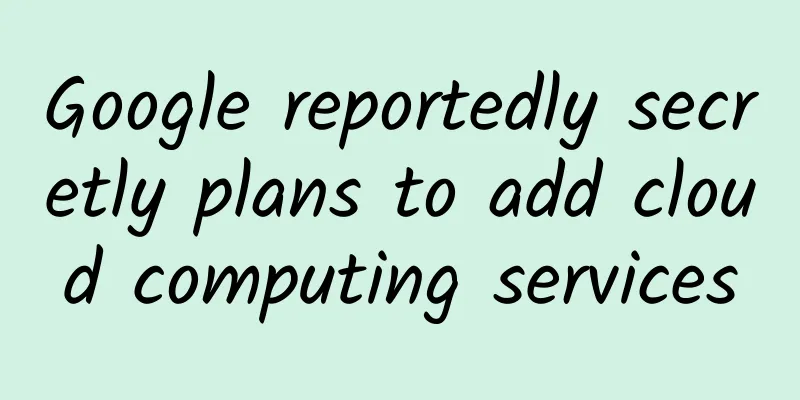Google reportedly secretly plans to add cloud computing services

|
According to Fortune, sources say Google is secretly increasing the cloud computing capabilities of its global content delivery network (CDN). In the past few months, while Amazon, Microsoft and IBM have taken turns to unveil new cloud computing data centers in China, India, Germany, the United Kingdom, South Korea and other places, another public cloud provider has remained unusually silent: Google. This is very strange because when it comes to providing cloud services to consumers, especially business consumers, location is very important. The farther away the computer servers and storage are, the longer the lag time of operations, and slow speed is definitely a major disadvantage of cloud services. The two sources said the company is considering an interesting plan. Google's cloud services are provided by four data center regions around the world, compared to Microsoft Azure, which has 20 data centers, and Amazon Web Services (AWS), which has 11 and will add another five next year. But Google has 70 data caches around the world to store video, audio and popular web data.
These endpoints are a vital part of what Google calls a “connectivity and content delivery network.” The plan — which two sources said is still under discussion — calls for these Google outposts to be paired with additional computing power, turning them into mini data centers of sorts. Both sources requested anonymity because their companies are working with Google. A Google spokesperson dismissed the rumors as speculation and declined to comment. One of the sources said Google's Cloud Engine group -- the cloud computing group -- is working with the company's internal infrastructure group to investigate whether they can add small clusters of computing power to these regional endpoints. On the one hand, this could end up being a tiered system, with big jobs running in Google's own massive data centers, which contain hundreds of thousands or even millions of servers, completely outstripping the capabilities of smaller content delivery network endpoints. If Google really decides to do this, the computing power of a small CDN would be even more limited than the computing power of the cloud computing engine group's own data centers. This scenario runs counter to the expectations of public cloud service users—customers who rent computing, storage and bandwidth services from Google, Amazon and Microsoft—who believe they can add nearly unlimited computing and storage capacity when needed. So this scenario is likely to result in two sets of infrastructure with two different pricing models. But what is certain is that Google needs to take action on global coverage as soon as possible. Amazon is the leader in public cloud infrastructure. According to an estimate by Gartner, an American IT research organization, last year, Amazon's computing power is ten times the total computing power provided by the next 14 cloud service competitors. Microsoft mainly targets commercial users. To help accelerate cloud traffic, Google and CDN market leader Akamai recently announced a partnership to connect Google’s own CDN interconnect directly to Akamai’s CDN. In September, Google announced partnerships with four other CDN providers: Cloudflare, Fastly, Level 3 Communications and Highwinds. But these partnerships are just the tip of the iceberg. Google, with its superior technical acumen, last year cut prices on a range of key storage and computing services, a move that bewildered Amazon, which is not good at letting other companies dictate price moves. Amazon sells its cloud services to business users, and many are unsure that the online search and advertising giant really cares about these cloud services (although Google has always publicly said it cares about cloud services). Google recently announced that Diane Greene, former CEO of VMware, a global cloud infrastructure and mobile business company, will be in charge of Google Cloud. Adrian Cockcroft, former chief cloud architect of Netflix and technical researcher at venture capital firm Battery Ventures, said he had never heard of Google's plan, but considering the business needs of greater geographical coverage and fast performance, this plan makes sense. If the Google Cloud team has figured out how to turn these CDN nodes into widespread mini data centers, it means they have listened to the demands of enterprise users, Cockcroft wrote in an email to Fortune. "From a technical perspective, it also means they have figured out how to reduce and package cloud services for smaller regional deployments, which is something Microsoft and another public cloud company have already achieved, and something Cockcroft believes Amazon Web Services will do better and better." |
<<: From now on, we have one less open source mobile phone system
Recommend
Tesla's old Model 3 price cut by RMB 10,000 to clear inventory, netizens: Don't be fooled
Tesla, which adopts the direct sales model, has a...
ChinaJoy is not so hot: it looks like the same old faces
The summit forum held one day before ChinaJoy (Ch...
The void is calling you! This strange feeling actually exists!
Audit expert: Taozi National Psychological Counse...
Internet giants lay out smart hardware platforms: developers worry about becoming puppets
What is the most popular entrepreneurial directio...
Why are succulents drought-tolerant?
Produced by: Science Popularization China Author:...
Three steps to create a social media hit
The creation of a hit product is a process of wor...
The smiley face symbol was sold at a sky-high price of over 2.5 million. Why is NFT so valuable?
Let me first show you some priceless works of art...
APP promotion: How to increase users three times at low cost?
1. Project Background A domestic financial APP pr...
I went to Kunming with my friends to drink tea. The most high-end tea tasting service comes with its own studio.
Kunming tea tasting has its own studio. Recommend...
Marketing = communication. Whether you like it or not, this era has come.
Let us first consider two examples. The first exa...
5 core strategies for rapid growth of Taobao stores
For brands that have just started their business,...
How to create new media articles that go viral?
Creating new media articles that go viral is the ...
Help! Why is someone feeding meat to Rose?
The editor sent me a picture, and my fruit flies ...
WeChat Business Group finally becomes independent, Tencent takes advantage of social networking to make a big plan
On the afternoon of May 6, Tencent announced the ...
10 tips on traffic
When it comes to understanding traffic , many peo...
![Uncovering the magic number behind user growth [5]](/upload/images/67cc4476dd35c.webp)








